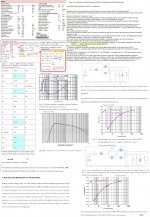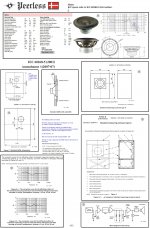What you say basically means that the variations due to manufacturing tolerances and measurement techniques and conditions, and the variations of 'my' measurement conditions, render measurements all but guesswork in all but a tightly controlled and fixed environment. This does not help at all!
Your interpretation is (again) incorrect. It's not "all but guesswork" (no need to start further hystrionics) but it is not as accurate as you seem to think. I already posted that your measured T/S may indicate the cone is a bit light. Did anyone else in this thread offer even that much?
A speaker has a mainly Cms change (break in related) will have essentially the same sensitivity before and after break in. That yours has a higher sensitivity than spec indicates a potentially lighter cone or more powerful magnet or both. Your Bl is not much different than spec, how about Re (which you never provided)?
Re can be tricky to measure, and the curve fit routines that some programs use can often overestimate it by a few tenths, which can/may throw all the calcs off.
Hi All,
FYI: Are the published Peerless T/S Parameters trustworthy?
Haven't seen bad ones. Excluding those which sometimes are posted to this forum. Never trust incomplete TS. So I agree with with Ron E as usual...
b
PS: INTERNATIONAL STANDARD IEC 60268-5
Part 5: Loudspeakers
http://www.ratchakitcha.soc.go.th/DATA/PDF/2553/E/028/5.PDF
Preconditioning
Permanent changes may take place in a loudspeaker as a result, for example, of motion of
the diaphragm.
Therefore, the loudspeaker should be preconditioned before measurements by application of a simulated program signal, in accordance with IEC 60268-1,
at the rated noise voltage for at least 1h.
Try this Generator:
Pink Noise Generator for Audio Testing Rod Elliott - ESP
Pink Noise Generator for Audio Testing
PSAM:
https://www.slideshare.net/AndyUnruh/improved-blocked-impedance-model-for-loudspeakers
FYI: Are the published Peerless T/S Parameters trustworthy?
Haven't seen bad ones. Excluding those which sometimes are posted to this forum. Never trust incomplete TS. So I agree with with Ron E as usual...

b
PS: INTERNATIONAL STANDARD IEC 60268-5
Part 5: Loudspeakers
http://www.ratchakitcha.soc.go.th/DATA/PDF/2553/E/028/5.PDF
Preconditioning
Permanent changes may take place in a loudspeaker as a result, for example, of motion of
the diaphragm.
Therefore, the loudspeaker should be preconditioned before measurements by application of a simulated program signal, in accordance with IEC 60268-1,
at the rated noise voltage for at least 1h.
Try this Generator:
Pink Noise Generator for Audio Testing Rod Elliott - ESP
Pink Noise Generator for Audio Testing
PSAM:
https://www.slideshare.net/AndyUnruh/improved-blocked-impedance-model-for-loudspeakers
Attachments
Last edited:
Thanks bjorno,
very interesting information but I think building a testing box of the given dimensions and design will not be happening anytime soon. I will be 'preconditioning' the drivers however in some way to loosen up the suspension and then re-measuring in a couple of different ways to see how the T/S parameters have changed.
Ron E, you are no doubt correct in everything you say but please remember that some of us only want to go as deep as they have time for with speaker design and therefore need information to aid this. First it was 'whining' and now 'histrionics' WTF? I'm a gardener and decorator by profession and have very little time to put into this hobby so it needs to count, so when I'm knackered after a hard day's work I can put my feet up and enjoy a bit of music with the knowledge that I have built my own system from scratch. It would not compare to anything you have designed or built but it gives me a great deal of satisfaction, especially as I have no background in the subject whatsoever.
Be nicer is what I'm hinting at here! ��
very interesting information but I think building a testing box of the given dimensions and design will not be happening anytime soon. I will be 'preconditioning' the drivers however in some way to loosen up the suspension and then re-measuring in a couple of different ways to see how the T/S parameters have changed.
Ron E, you are no doubt correct in everything you say but please remember that some of us only want to go as deep as they have time for with speaker design and therefore need information to aid this. First it was 'whining' and now 'histrionics' WTF? I'm a gardener and decorator by profession and have very little time to put into this hobby so it needs to count, so when I'm knackered after a hard day's work I can put my feet up and enjoy a bit of music with the knowledge that I have built my own system from scratch. It would not compare to anything you have designed or built but it gives me a great deal of satisfaction, especially as I have no background in the subject whatsoever.
Be nicer is what I'm hinting at here! ��
scottjoplin, 40Hz is a rough guess at the moment as my fullrangers go down that far but in order to play louder I'll probably need a bit more protection from over excursion so I'll end up crossing over higher than this. I don't like music loud to be honest, rarely above 90db so it will all depend on my final system set up after all the 'preconditioning' and measurements.
Cheers
Cheers
I'm a gardener and decorator by profession and have very little time to put into this hobby so it needs to count, so when I'm knackered after a hard day's work I can put my feet up and enjoy a bit of music with the knowledge that I have built my own system from scratch.
So build it already.
For that woofer using a Linkwitz transform, T/S and box size matters hardly at all. 40L seems like a decent size, you might even try 30L for a little punch. Play them without the transform for a while (you might find you don't need it) then measure T/S and design your LT circuit for whatever Fc and Q you desire. Consider placing them close to your mains (perhaps even designing them to be used as stands) then you can cross over higher and take more work off of the mains and get better performance.
For a vented box, you can run them in for a day at 15-30Hz free air (I wouldn't do a high power preconditioning) and remeasure T/S to see what happens. What you do from there depends on how much space you have. More radiation area means less excursion and less distortion for the same SPL. This is where Isobaric falls down.
A refreshing paper from Ted Jordan about T/S parameters almost bureaucratic game...
http://www.ejjordan.co.uk/PDFs/parameter_game.pdf
In the design and development of loudspeaker drive units to clients’ specifications,
the so-called "Theil Small" parameters are often a contentious issue.
Apart from the occasions when we are asked for values that are mutually
incompatible, we feel that the now almost universal use of these parameters for the
computerised modeling of enclosure design can sometimes produce misleading
results. Further, this totally aseptic approach to design is not always accompanied by
the necessary understanding of the fundamental principles.
I have no argument with computer aided designs per sé, provided that the operative
word is "aided". However, it seems almost as though parameter crunching has
become a computer game where the object is to juggle parameters to achieve an
often arbitrarily chosen response alignment to quite fatuous levels of accuracy.
In fact, such accuracy may be far less than imagined due to the difficulties in
determining the drive unit parameters in the first place. (Words like "music" and
"listening" seem almost outdated).
http://www.ejjordan.co.uk/PDFs/parameter_game.pdf
Thanks Ron E what you say makes sense to me and I'll certainly be incorporating it into my design approach. Cheers
GDO, that's a very interesting quote from Ted Jordan so I'll check oit the link to the pdf that you provided. Cheers
Scottjoplin, I'll get back to you on my current set-up. Cheers
GDO, that's a very interesting quote from Ted Jordan so I'll check oit the link to the pdf that you provided. Cheers
Scottjoplin, I'll get back to you on my current set-up. Cheers
It depends on how you sub integrates in your system.
If the overall response of your system is flat, you might get some added bass extension but the presence of the sub in your system will be mostly unnoticable, and btw, this is how it should be in a true hifi system.
Then, if what you expect from you sub is to deliberately boost the bass department, to get the sound of a pair of Beats headphones , it's a totally different story and a flat response is not the target you need. You need a bump of some kind in the response, and you might get it by eq, or acoustically with a BR or Bandpass cabinet using a non flat alignment.
, it's a totally different story and a flat response is not the target you need. You need a bump of some kind in the response, and you might get it by eq, or acoustically with a BR or Bandpass cabinet using a non flat alignment.
It's no longer about Hifi, but let's call it about Bass Culture...
If the overall response of your system is flat, you might get some added bass extension but the presence of the sub in your system will be mostly unnoticable, and btw, this is how it should be in a true hifi system.
Then, if what you expect from you sub is to deliberately boost the bass department, to get the sound of a pair of Beats headphones
It's no longer about Hifi, but let's call it about Bass Culture...
- Status
- This old topic is closed. If you want to reopen this topic, contact a moderator using the "Report Post" button.
- Home
- Loudspeakers
- Subwoofers
- Peerless xxls specs wrong?



